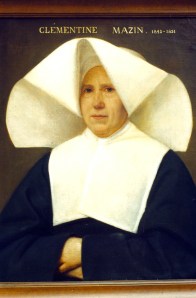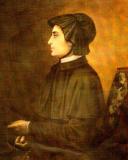(Images used with permission of the Daughters of Charity Provincial Archives)

Mother Clementine Mazin, Superioress of the Daughters of Charity at the time of the American union with France.
The top photo shows St. Elizabeth Ann Seton, wearing the attire of the community she founded, the Sisters of Charity of St. Joseph’s. Mother Seton’s attire is commonly known as the “black cap”. Mother Seton died in 1821; the community in Emmitsburg joined with the French Daughters of Charity in 1850. The bottom photo shows Mother Clementine Mazin, the Superioress General of the Daughters of Charity at the time of the American union with France.
On March 25, 1850, Sisters in Emmitsburg renewed their vows according to the vow formula of the Daughters of Charity for the first time. The formal union came in November of 1850. During the year 1850 four sisters were sent from Emmitsburg to France to become imbued with the spirit and practices of the Daughters of Charity: Sisters Vincentia Repplier, Valentine Latouraudais, Ann de Sales Farren, and Marie Louise CaulfIeld. Sister Marie Louise spoke French fluently and was chosen to be trained as the fIrst secretary of the American province, an office she held for almost half a century. In 1851 Sisters Etienne Hall and Ann Simeon Norris traveled to France. Both Sisters later served as Visitatrix of the American Province. [note 1]
During a retreat for sister servants held at Emmitsburg in October 1850, Sister Vincentia and her three companions, recently returned from France, modeled for all the blue habit and white cornette. On December 7, 1851, all the Sisters in Emmmitsburg wore the cornette for the first time. [note 2]
It took until September of 1855 for the entire American province to change from the black cap to the cornette. There were several reasons for this. One was the geographic reach of the province. By 1850 the American province had spread far beyond Emmitsburg, with Sisters as far north as upstate New York, as far south as New Orleans and Mobile, and as far west as St. Louis and Detroit. Another was the difficulty of obtaining the needed material. Since the time of Vincent and Louise it had been the custom of the Daughters of Charity for all Sisters to have their attire provided by the Mother House in Paris. In 1850, the Mother House did not make each Sister’s habit, but the material, a heavy, navy-blue wool, was imported from France. Difficulties in acquiring material, along with the time required to make habits for all the American Sisters, meant that the change from the black cap to the cornette was a gradual one. The issue of importing material from France came up again during the Civil War; this incident will be the subject of Part 5.
Notes:
note 1. Sr. Daniel Hannefin, Daughters of the Church: A Popular History of the
Daughters of Charity in the United States, 1809-1987 (New City Press, 1989), p.92.
note 2. Provincial Annals, RG 7-8-3, 1851; Ellin Kelly, Numerous Choirs, p.186.



Thank you very much for sharing this important information with all of us. It is extremely fascinating to read this history through your blogs and view it through your well-researched displays.
LikeLiked by 1 person
I was taught by the Daughters of Charity when I was young. I always loved the cornette. I thought they were the most beautiful women I had ever seen. While I miss the cornette, I can only imagine it was hard to get around in it. Love your blog and love the Daughters, too.
LikeLike
Ms. Lyons – Thank you for the nice comments about the Daughters and the blog. The cornette is still so beloved nearly 50 years later. That’s one of the reasons we’re doing this series of posts. Glad you’re enjoying them!
LikeLiked by 1 person
Enjoying the blog about the Daughters’ habits and the Cornette! I pin photos of the Daughters of Charity–current and historic–on this Pinterest Board “Daughters of Charity–Daughters of Charity of St. Vincent de Paul–then and now:” http://pinterest.com/bdavis003/daughters-of-charity/
Enjoy!
LikeLiked by 1 person
Great! Thanks for the plug . Will take a look at the Pinterest page.
LikeLiked by 1 person
I read in a book by Donahue NURSING THE FINEST ART that Sr. Valentine Latouraudais gave the sacreament of “Extreme Unction::when she was a missionary. Any more to add to this??
LikeLike
Sr. Agnes – I am not familiar with this book; it’s not in our collection. In looking at accounts of Sr. Valentine’s life, I cannot find any references to her being a missionary – at least not a foreign missionary. The one mission she had outside of the U.S. was in 1850, when she was sent to France at the time that Elizabeth Ann Seton’s community united with the French Daughters of Charity. One of her companions, Mother Etienne Hall, kept a detailed diary of the trip, and the diary contains no references to any of the Sisters administering the sacrament of Extreme Unction. Sister Valentine did serve during the Civil War, so I checked our transcribed Civil War Annals. and, while there are several accounts of Sisters giving the sacrament of Extreme Unction, none of them were connected with Sister Valentine. The best answer I can give is that I cannot confirm or deny that she ever administered the sacrament of Extreme Unction. It could have happened, especially in the context of the Civil War, but I cannot say with certainty that it did.
LikeLiked by 1 person
Thank you for the information! The administration of Extreme Unction is a problem that is now arisen because of the shortage of priest who say that , since the sacrament involves the forgiveness of sins, ONLY priests may administer it!! So it is interesting that the problem is not a new one. By the way, the book NURSING THE FINEST ART is a book that you should have – very helpful for researchers – but hope it is truthful!!!!!!!!
LikeLiked by 1 person
Sisters administering certain sacraments did happen – there are a number of accounts in our Civil War Annals of deathbed baptisms by Sisters, in situations where priests were not available to perform the baptism. Sisters administering Extreme Unction, did happen on a few occasions, and no doubt it happened out of necessity – during the Civil War the Sisters found themselves in many situations where priests were not readily available. I don’t know what the accepted practice for Extreme Unction was during the Civil War, but I’m sure the Sisters would not have overstepped their bounds – administered sacraments they were not allowed to administer.
LikeLiked by 1 person
I was educated by the Daughters of Charity from 1961-1965 at Seton High School in Endicott,New York.Every Fall we would wait in anticipation for the Sisters to return from their summer vacation and recess
1964 would be a very different year in that in addition to new faces,the sisters would return in a new midified habit.Something their community had worn for over three hundred years. Christian Dior the world famous designer had been contracted to design a new modified habit. Gone was the long blue/gray habit, the large chaplet of rosary beads and the internationally recognizes cornette. 45,000 women world wide made the change. How priviledged I felt to be a part of that CHANGE.✝️✝️✝️
LikeLike